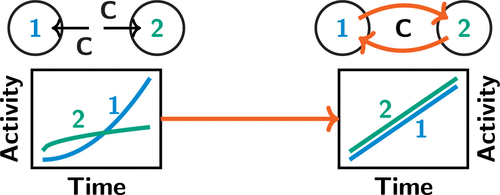当前位置:
X-MOL 学术
›
ACS Synth. Biol.
›
论文详情
Our official English website, www.x-mol.net, welcomes your
feedback! (Note: you will need to create a separate account there.)
Enhanced Population Control in a Synthetic Bacterial Consortium by Interconnected Carbon Cross-Feeding.
ACS Synthetic Biology ( IF 3.7 ) Pub Date : 2019-11-25 , DOI: 10.1021/acssynbio.9b00316 Pauli S Losoi 1 , Ville P Santala 1 , Suvi M Santala 1
ACS Synthetic Biology ( IF 3.7 ) Pub Date : 2019-11-25 , DOI: 10.1021/acssynbio.9b00316 Pauli S Losoi 1 , Ville P Santala 1 , Suvi M Santala 1
Affiliation

|
Engineered microbial consortia can provide several advantages over monocultures in terms of utilization of mixed substrates, resistance to perturbations, and division of labor in complex tasks. However, maintaining stability, reproducibility, and control over population levels in variable conditions can be challenging in multispecies cultures. In our study, we modeled and constructed a synthetic symbiotic consortium with a genetically encoded carbon cross-feeding system. The system is based on strains of Escherichia coli and Acinetobacter baylyi ADP1, both engineered to be incapable of growing on glucose on their own. In a culture supplemented with glucose as the sole carbon source, growth of the two strains is afforded by the exchange of gluconate and acetate, resulting in inherent control over carbon availability and population balance. We investigated the system robustness in terms of stability and population control under different inoculation ratios, substrate concentrations, and cultivation scales, both experimentally and by modeling. To illustrate how the system might facilitate division of genetic circuits among synthetic microbial consortia, a green fluorescent protein sensitive to pH and a slowly maturing red fluorescent protein were expressed in the consortium as measures of a circuit's susceptibility to external and internal variability, respectively. The symbiotic consortium maintained stable and linear growth and circuit performance regardless of the initial substrate concentration or inoculation ratio. The developed cross-feeding system provides simple and reliable means for population control without expression of non-native elements or external inducer addition, being potentially exploitable in consortia applications involving precisely defined cell tasks or division of labor.
中文翻译:

通过相互连接的碳交叉供料,增强了合成细菌联盟中的种群控制。
在利用混合底物,抗干扰性以及在复杂任务中分工方面,经过改造的微生物联盟可提供优于单一文化的多个优势。然而,在多物种文化中,保持稳定性,可再现性以及在可变条件下控制种群水平可能是具有挑战性的。在我们的研究中,我们通过遗传编码的碳交叉供料系统对合成的共生财团进行了建模和构建。该系统基于大肠杆菌和拜氏不动杆菌ADP1菌株,它们都被设计为无法依靠葡萄糖生长。在补充有葡萄糖作为唯一碳源的培养物中,两种菌株的生长通过葡萄糖酸盐和乙酸盐的交换来实现,从而导致对碳利用率和种群平衡的内在控制。我们通过实验和建模研究了在不同接种率,底物浓度和培养规模下稳定性和种群控制方面的系统鲁棒性。为了说明该系统如何促进合成微生物聚生体之间遗传回路的划分,在聚生体中表达了对pH敏感的绿色荧光蛋白和缓慢成熟的红色荧光蛋白,分别作为回路对内部和外部变异敏感性的量度。无论初始底物浓度或接种比例如何,共生联盟均保持稳定且线性的生长和电路性能。
更新日期:2019-11-28
中文翻译:

通过相互连接的碳交叉供料,增强了合成细菌联盟中的种群控制。
在利用混合底物,抗干扰性以及在复杂任务中分工方面,经过改造的微生物联盟可提供优于单一文化的多个优势。然而,在多物种文化中,保持稳定性,可再现性以及在可变条件下控制种群水平可能是具有挑战性的。在我们的研究中,我们通过遗传编码的碳交叉供料系统对合成的共生财团进行了建模和构建。该系统基于大肠杆菌和拜氏不动杆菌ADP1菌株,它们都被设计为无法依靠葡萄糖生长。在补充有葡萄糖作为唯一碳源的培养物中,两种菌株的生长通过葡萄糖酸盐和乙酸盐的交换来实现,从而导致对碳利用率和种群平衡的内在控制。我们通过实验和建模研究了在不同接种率,底物浓度和培养规模下稳定性和种群控制方面的系统鲁棒性。为了说明该系统如何促进合成微生物聚生体之间遗传回路的划分,在聚生体中表达了对pH敏感的绿色荧光蛋白和缓慢成熟的红色荧光蛋白,分别作为回路对内部和外部变异敏感性的量度。无论初始底物浓度或接种比例如何,共生联盟均保持稳定且线性的生长和电路性能。









































 京公网安备 11010802027423号
京公网安备 11010802027423号